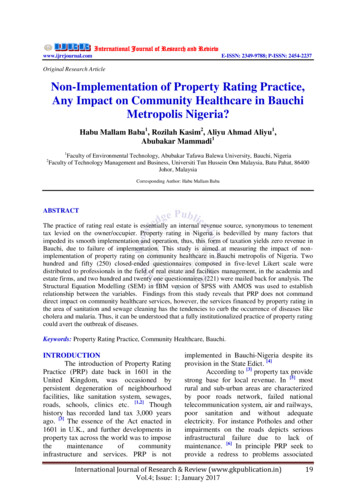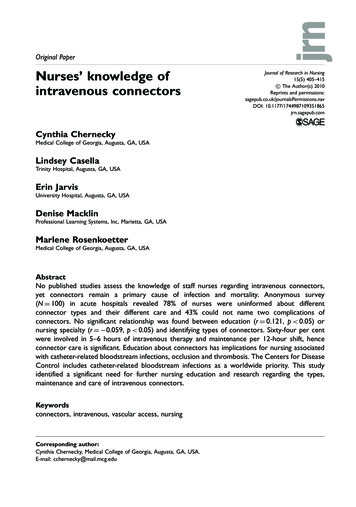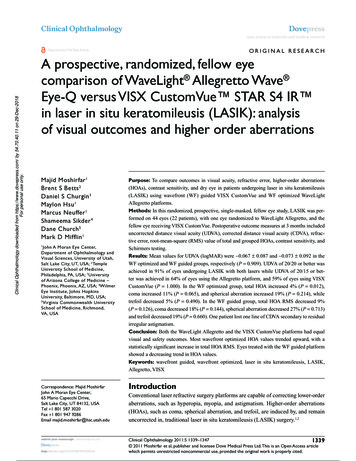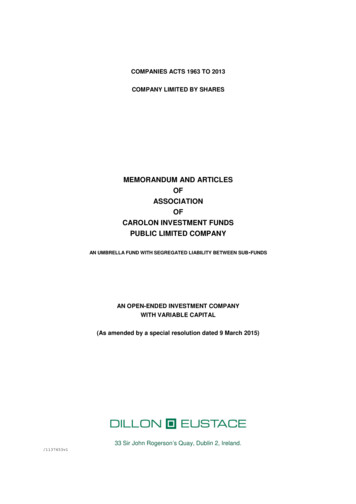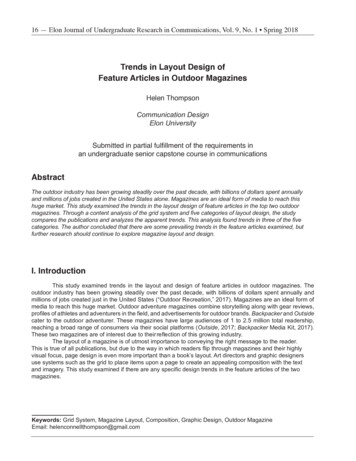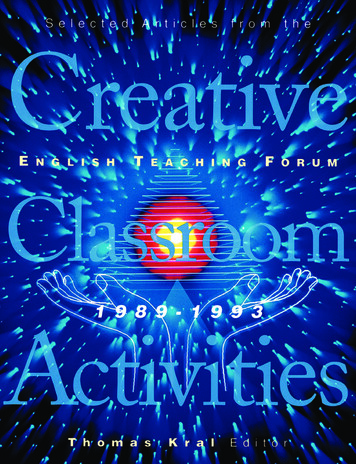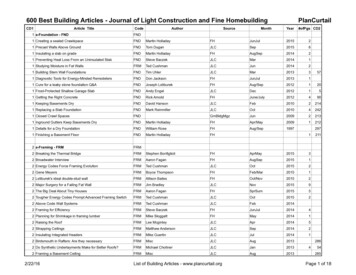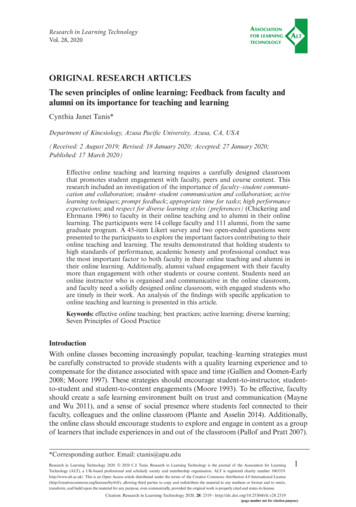
Transcription
Research in Learning TechnologyVol. 28, 2020ORIGINAL RESEARCH ARTICLESThe seven principles of online learning: Feedback from faculty andalumni on its importance for teaching and learningCynthia Janet Tanis*Department of Kinesiology, Azusa Pacific University, Azusa, CA, USA(Received: 2 August 2019; Revised: 18 January 2020; Accepted: 27 January 2020;Published: 17 March 2020)Effective online teaching and learning requires a carefully designed classroomthat promotes student engagement with faculty, peers and course content. Thisresearch included an investigation of the importance of faculty–student communication and collaboration; student–student communication and collaboration; activelearning techniques; prompt feedback; appropriate time for tasks; high performanceexpectations; and respect for diverse learning styles (preferences) (Chickering andEhrmann 1996) to faculty in their online teaching and to alumni in their onlinelearning. The participants were 14 college faculty and 111 alumni, from the samegraduate program. A 45-item Likert survey and two open-ended questions werepresented to the participants to explore the important factors contributing to theironline teaching and learning. The results demonstrated that holding students tohigh standards of performance, academic honesty and professional conduct wasthe most important factor to both faculty in their online teaching and alumni intheir online learning. Additionally, alumni valued engagement with their facultymore than engagement with other students or course content. Students need anonline instructor who is organised and communicative in the online classroom,and faculty need a solidly designed online classroom, with engaged students whoare timely in their work. An analysis of the findings with specific application toonline teaching and learning is presented in this article.Keywords: effective online teaching; best practices; active learning; diverse learning;Seven Principles of Good PracticeIntroductionWith online classes becoming increasingly popular, teaching–learning strategies mustbe carefully constructed to provide students with a quality learning experience and tocompensate for the distance associated with space and time (Gallien and Oomen-Early2008; Moore 1997). These strategies should encourage student-to-instructor, studentto- student and student-to-content engagements (Moore 1993). To be effective, facultyshould create a safe learning environment built on trust and communication (Mayneand Wu 2011), and a sense of social presence where students feel connected to theirfaculty, colleagues and the online classroom (Plante and Asselin 2014). Additionally,the online class should encourage students to explore and engage in content as a groupof learners that include experiences in and out of the classroom (Pallof and Pratt 2007).*Corresponding author. Email: ctanis@apu.eduResearch in Learning Technology 2020. 2020 C.J. Tanis. Research in Learning Technology is the journal of the Association for LearningTechnology (ALT), a UK-based professional and scholarly society and membership organisation. ALT is registered charity number 1063519.http://www.alt.ac.uk/. This is an Open Access article distributed under the terms of the Creative Commons Attribution 4.0 International /), allowing third parties to copy and redistribute the material in any medium or format and to remix,transform, and build upon the material for any purpose, even commercially, provided the original work is properly cited and states its license.1Citation: Research in Learning Technology 2020, 28: 2319 - http://dx.doi.org/10.25304/rlt.v28.2319(page number not for citation purpose)
C.J. TanisIn 1987, Chickering and Gamson proposed the model, Seven Principles of GoodPractice, to facilitate engagement in the face-to-face or on-ground classroom. In 1996,Chickering and Ehrmann, appreciating the demand for online learning, expanded thisconstructivist model for online environments. Their framework has become a reference for best practice in online design and instruction (Bangert 2004). Collaboration,engagement and differentiation are the overarching themes of this model that includeseven principles: Faculty–student communication and collaboration; student–studentcommunication and collaboration; active learning techniques; prompt feedback; appropriate time for tasks; high performance expectations; and respect for diverse learningstyles (reframed in this context as ‘preferences’).Faculty–student communication creates a sense of online community that is initiated through emails, introductions, faculty and student biographies, and photos.Jones et al. (2009) found that video introductions by faculty and students, emailsand video calls, online chats and discussion boards improved students’ experiencesin the online class despite differences in language, culture and time zone. In Martin and Bolliger’s (2018) study, students found icebreakers used at the beginning ofthe term to be a highly beneficial engagement activity. Prompt communication andfeedback by faculty also engages students and compensates the distance associatedwith online learning (Moore 1997). According to Lewis and Abdul-Hamid’s (2006)qualitative study with 30 online instructors, exemplar instructors provide individualstudent feedback throughout every stage of the course and contact students who areabsent through reminder emails and messages. Additionally, timely instructor feedback promotes student motivation and course satisfaction (Dahalan et al. 2013) andcultivates positive connections with the University (Lewis and Abdul-Hamid 2006).Communication can be achieved multidimensionally between faculty and studentsand includes course-specific and informal dialogues. Lewis and Abdul-Hamid (2006)identified a faculty member in their study who developed a ‘Harmony House’ whereinformal chatting via the classroom café enhanced the communication among peersand faculty (p. 88). Sitzman and Lener (2010) investigated students’ perceptions ofonline faculty. The students identified these caring behaviours as important for theirlearning: faculty with an empathetic presence, who are experts in the field, and arefully engaged in the class content.Student–student communication and collaboration provides opportunities forstudents to share experiences, resources and ideas, and engage in learning as a community (Bolliger and Martin 2018). According to Winkler-Prins et al. (2007), theonline classroom should be constructed and facilitated in such a way to avoid feelingsof isolation and loneliness. Interaction can be facilitated through the use of carefullyconstructed written discussions and the use of student-generated audio and videoresponses (Gedike, Kiraz and Ozden 2013). These are means to promote connectivitywith course content and fellow colleagues (Bolliger and Des Armier 2013). Accordingto Berge (2002), group work instead of solo activity is recommended to prevent isolation and encourage critical thinking and application of course content. ‘Learning isenhanced when it is more like a team effort than a solo race. Good learning, like goodwork, is collaborative and social, not competitive and isolated’ (Johnson 2014, p. 43).High performance expectations, respect for diverse learning preferences, activelearning techniques and appropriate time for tasks are necessary for student engagement in class content. According to Johnson (2014), high expectations are importantfor all students, from the low motivated and the ill-prepared to the high performing.Instructors should direct students to the course syllabus and course module where2(page number not for citation purpose)Citation: Research in Learning Technology 2020, 28: 2319 - http://dx.doi.org/10.25304/rlt.v28.2319
Research in Learning Technologyclass expectations, goals and objectives are clearly outlined, and then hold students tothose standards (Lewis and Abdul-Hamid 2006). Young (2006) surveyed 199 onlinestudents and many commented on the importance of instructors placing high standards in online courses. Additionally, students stated that accountability and responsibility to class expectations and coursework made the course higher quality. Studentsdesired to demonstrate proficiency, increase their knowledge of the topic and be challenged in the process.Students excel in the online classroom when allowed to engage and demonstrateability with activities that match their learning preferences (Johnson 2014). Respectfor diverse learning preferences integrates direct experiences outside the classroomthat include shadowing and interning, and indirect experiences in the classroom thatinclude case study development, simulations and stories (Storytorials; Fink 2013).Online classes should not merely be a repository of information or consist solely ofthe ‘Holy Trinity of online instruction’ (Craig 2015, para 8), with a repeat of thelecture, discussion group and weekly assignment. Respect of learning preferencesalso includes online orientation and technical assistance so that students who feelunequipped can work smoothly and without barriers (Çakýroðlu 2014). According toWhite, Brown and Sugar (2007), the success of their department’s transition to onlinelearning began with technology resources and orientation sessions for new students.Students also had continuous access to a technical assistant.Active learning encourages students to engage in the course content with theircolleagues. It is ‘learning by doing’ (Bolliger and Des Armier 2013, p. 201). Learningby doing replaces passive listening, memorising and regurgitating answers with interactive discussions, reflections and relative applications (Johnson 2014). According toHove and Corcoran (2008), interactive multimedia is one means of promoting activelearning that makes the course effective and alive. In their study with online students,students who had unlimited access to lecture video presentations earned higher gradesthan students who did not have the same access. The availability of such presentationsprovides students with study aids and offers a measure of control over their learningprocess. In another study by Lewis and Abdul-Hamid (2006), an innovative onlineteacher incorporated contemporary news articles and videos to facilitate active learning. Another instructor invited guest speakers to her online class for synchronouschats to facilitate student learning and engagement about the subject matter. Berge(2002) encourages authentic projects and problem-solving situations through the useof group projects, reflection assignments and interactive discussions. Gedik, Kirazand Ozden (2013) state that authentic, coherent, meaningful and purposeful activitiesimmerse learners in real-life scenarios. This develops new knowledge that relates tostudents’ prior knowledge and experiences.Chickering and Ehrmann (1996) stated, ‘Time plus energy equals learning. Learning to use one’s time well is critical for students and professionals alike’ (p. 4). Theonline classroom must be designed effectively, and directions for student navigationmust be included to preserve time for learning (Fish and Wickersham 2009). Additionally, course expectations should be clearly listed in the syllabus and online classroomand include the deadlines and responsibilities of the student and the instructor of thecourse (Berge 2002). Students must have well-written instructions for all courseworkto ensure they are on pace for successful completion (Fish and Wickersham 2009).According to Hathaway (2014), the Seven Principles of Good Practice (Chickeringand Erhmann 1996) focuses on student engagement and is useful for creating activeonline learning and understanding. Bali (2014) stated that these principles continue toCitation: Research in Learning Technology 2020, 28: 2319 - http://dx.doi.org/10.25304/rlt.v28.2319 3(page number not for citation purpose)
C.J. Tanisbe acceptable to enhance online learning and can also be used to evaluate universitycourses. In 2012, this author, the director and faculty member of a 36-unit master’sdegree program collaborated with the universities’ ‘Office of Innovative Teaching andTechnology (ITT)’ to create a 100% online programme. Prior to this year, 25% ofthe programme was instructed online. The ITT designers integrated the constructs ofthe Seven Principles of Good Practice (Chickering and Erhmann 1996) in the onlineclasses. They also worked with the faculty in this master’s programme to develop thefollowing online curriculum: Two additional core classes (seminar in professional literature, and curriculum theory and design); five additional content classes (coaching,teaching, exercise science, administration and sociology); and two capstone classes.In this research, the author-director evaluated the online learning preferences fromthe graduating students from this master’s programme. The author also exploredthe online teaching preferences from the faculty in this master’s programme, becauseresearch is lacking within the faculty population. Since the online master’s programmewas designed using Chickering and Ehrmann’s (1996) online model as a framework,the author used this model as the construct for investigation. The purpose of thisstudy was two-fold: To investigate alumni perceptions of the Seven Principles ofOnline Learning to their online learning in this master’s programme, and to investigatefaculty perceptions of the Seven Principles of Online Learning to their online teachingin this master’s programme. The research questions were: (1) How important are eachof the principles of Chickering and Ehrmann’s (1996) online model for online learning? Which factors positively and negatively influence alumni in their online learning?(2) How important are each of the principles of Chickering and Ehrmann’s (1996)online model for online teaching? Which factors positively and negatively influencefaculty in their online teaching?In a previous study, Schwiebert (2012) surveyed online community students todetermine the importance of each of Chickering and Ehrmann’s (1996) Seven Principles of Online Learning. He developed 35 Likert scale statements using a 5-pointscale: (1) completely unimportant to my online learning, (2) mostly unimportant, (3)somewhat important, (4) fairly important and (5) critically important to my onlinelearning. According to Leedy and Ormrod (2019), rating scales are useful to quantify participant attitudes or perceptions on a specific topic. However, it is limitedbecause the researcher is unable to gather clarifying responses. A Likert scale surveywas implemented in this research to determine the importance of each of the SevenPrinciples of Online Learning for alumni and faculty. Additionally, two open-endedquestions were posed so the participants could elaborate and qualify their responsesto the factors that influenced their online learning and teaching. Schweibert’s (2012)publication did not include statistical information for the survey, and therefore, theinitial step in this research was to conduct a reliability study.MethodsParticipants and preliminary analysisThe research was approved by the University’s IRB board. Participants for this preliminary analysis were currently enrolled students in the author-director’s onlinegraduate programme. They were informed of confidentiality, the option to declineparticipation without penalty and the ability to withdraw from the study as needed.One hundred students were invited to complete two surveys and 35 agreed. The first4(page number not for citation purpose)Citation: Research in Learning Technology 2020, 28: 2319 - http://dx.doi.org/10.25304/rlt.v28.2319
Research in Learning Technologysurvey was Schweibert’s (2012) Seven Principles of Online Learning, consisting of 35Likert scale statements. A reliability analysis was administered on the five Likert scaleitems in each of these seven principles. Hair et al. (2010) recommend reliability valuesto be a minimum of 0.60 when used in exploratory surveys, such as the one used inthis study. The results for each principle in this first survey were as follows: Principle1 (α 0.60), Principle 2 (α 0.76), Principle 3 (α 0.69), Principle 4 (α 0.75), Principle 5 (α 0.64), Principle 6 (α 0.86) and Principle 7 (α 0.74). The author usedthis survey as the basis for the new research and provided an additional 11 statementsbecause they were pertinent to the design and teaching protocols of the 36-unit graduate programme.A reliability analysis was again administered on the results from the second survey.Five additional Likert scale items were added to the first principle, faculty–studentcommunication. The reliability analysis, comprised of 10 Likert scale items, revealedan improvement in reliability (α 0.87), with all items being acceptably correlated witheach other in this principle (r 0.30). Therefore, all 10 items were used in the surveyof the proposed research. Two additional Likert scale items were added to the secondprinciple, student–student communication and collaboration. The reliability analysis onthis second principle, now comprised of seven Likert scale items, showed this updatedsurvey to be acceptable for reliability (α 0.74), with all items being acceptably correlated with each other in this principle (r 0.30). These seven Likert scale statementswere used in the survey of the proposed research. The reliability analysis on the thirdprinciple, active learning techniques, now comprised of six Likert scale items, showedthis updated survey to improve in reliability (α 0.73), with all items being acceptably correlated with each other in this principle (r 0.30). Again, all six Likert scaleitems were used in the survey of the proposed research. The reliability analysis on thefourth principle, prompt feedback, now contained six Likert scale items. The alphascore was acceptable (α 0.70). All items were acceptably correlated with each otherin this principle (r 0.30), and all items were used in the final survey of the proposedresearch as the alpha score reduced if removed. The reliability analysis on the fifthprinciple, appropriate time for tasks, included six items. The reliability score decreasedto α 0.58 in this second analysis. The added question did not show correlation withthe other items (r 0.30), and Cronbach’s alpha improved to the original score of α 0.61 if the item was deleted, so this question was removed in the proposed research.The reliability analysis on the sixth principle, high performance expectations, includedsix items and had the same reliability score as the first survey (α 0.86). All items wereacceptably correlated with each other in this principle (r 0.30) and were used in theproposed research. The reliability analysis on the seventh principle, respect for diverselearning styles, included the same five Likert scale items as the first survey. The resultsshowed a reliability score of α 0.79, with all items acceptably correlated with eachother in this principle (r 0.30). All items were used in the proposed research (seeAppendix for both surveys).Participants and methodTwo sets of participants were recruited for the research. The first group of participants were full-time and adjunct faculty, currently teaching in the author-director’sonline programme. They completed the 45-item online survey with the followingfive response options: (1) completely unimportant to my online teaching, (2) mostlyCitation: Research in Learning Technology 2020, 28: 2319 - http://dx.doi.org/10.25304/rlt.v28.2319 5(page number not for citation purpose)
C.J. Tanisunimportant, (3) somewhat important, (4) fairly important and (5) critically important to my online teaching. There were two open-ended questions at the end of thesurvey that prompted the faculty to identify factors that positively and negativelyinfluenced their online teaching. The second group of participant
Technology (ITT)’ to create a 100% online programme. Prior to this year, 25% of the programme was instructed online. The ITT designers integrated the constructs of the . Seven Principles of Good Practice (Chickering and Erhmann 1996) in the online classes. They also worked w


